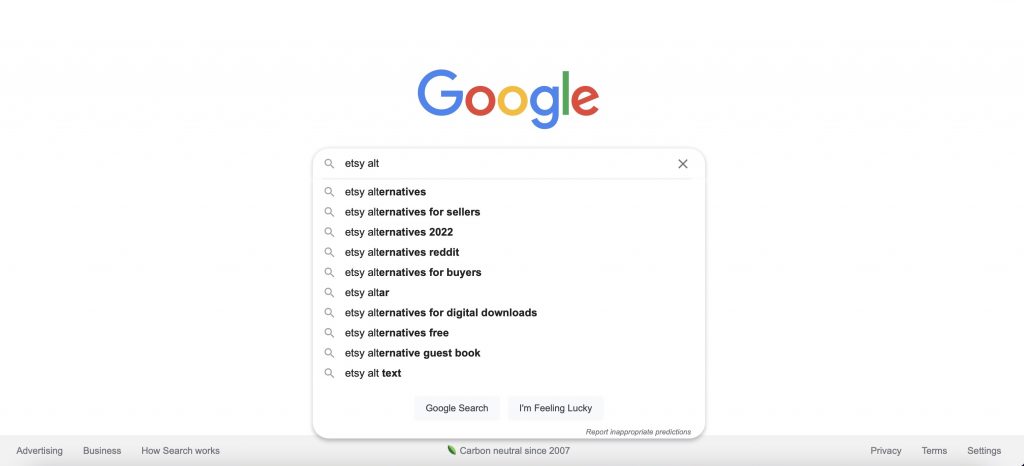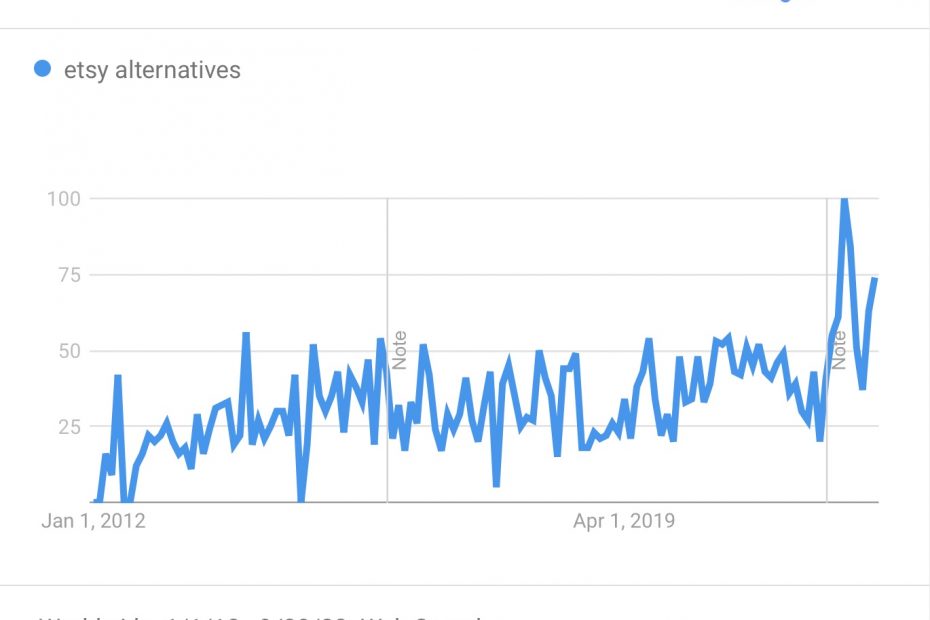#EtsyStrike, The Rise of Etsy Alternatives, A New Union and a Co-op
This article was written in response to Medium’s call for submissions: Your invitation to tell us about 2022
2022 will be remembered as the year that workers had had enough. Employed persons enjoyed rising support for unions and unionization and began self-organizing in big numbers including, for the first time, in the tech sector at Amazon warehouses and Apple stores. But gig workers – including Etsy sellers – aren’t protected by union laws. We had to get more creative.
For Etsy crafters, 2022 was a transformative year. We had the lowest lows, the highest highs, and a lot of growth in between. This is a walk through the big events:
Starting the Year with Deteriorating Service
Most Etsy crafters started the year off with a feeling of general dissatisfaction. Crafters’ margins have been slowly squeezed on the Etsy platform for years, into a race-to-the-bottom well known to gig workers of all kinds:
- Increasing fees: with up to twelve different fees and a mandatory ad program, the average Etsy sale can now take anywhere from 10% to 40% in commissions.
- Increasing pressure to host sales, discount products, and pay for on-site advertising to get “seen”
- Taking advantage of “information assymetry”: tweaking algorithms behind-the-scenes in ways that benefit the company’s business model but create extra work and uncertainty for the crafter. (Big platforms have been known to use game theory to manipulate vendor behavior, and there’s no reason to think Etsy is any different)
- Creating unfair competition by flooding an insincere marketplace with inauthentic products and failing to enforce handmade policies on dropshippers and re-sellers
Record Profits and a 30% Fee Increase
In February, Etsy announced record profits in 2021 and a 30% transaction fee increase in the same week. That’s right: they were doing great… so they needed to charge crafters more.
There’s really no other way to describe how this felt to crafters but “corporate greed.” This was the second transaction fee hike since the company went the way of Wall Street in 2015: doubling in less than 4 years, from 3.5% to 5% in 2018 and to 6.5% in 2022. Promises made during the previous fee hikes were never kept.
The Etsy Strike
The February fee announcement was the catalyst for the #EtsyStrike.
Between February and April, in just 7 weeks, 30,000 shops and 80,000 petition signers spontaneously self-organized in anger. The Etsy Strike was an 8-day protest of the new fees by crafters taking their product listings off the site. The strike was timed to take place the week the new fees were enacted in April. Strike leaders demanded Etsy cancel the fee increase and more.
This amount of coordination was unprecedented. Like most big tech platforms, Etsy users are not easily able to congregate off-site. The Etsy “Community Forum” is highly moderated and many controversial comments and threads are censored. Crafters dispersed across the internet needed a way to connect, and with this fee increase, Etsy provided it.
During the week of the strike, the buzz was electric. Celebrities and one of the original Etsy founders shared their support for the strike on social media. Local TV stations interviewed crafters about the strike, from California to Quebec.
On its end, Etsy downplayed the strike, despite being asked about it at posh Wall Street events and investor meetings. They never addressed the strikers, not even with the most bland of acknowledgements. They sent a statement to journalists who asked but not to the strikers themselves.
Although the strike didn’t cancel the fee increase, it gained something more valuable. Strikers received validation from the enthusiastic response of the community. That fueled them to self-organize into a cause that they vowed to continue.
Getting Organized
After the strike, Etsy gave every possible signal to crafters that their strategy going forward would be more of the same: more for investors, less for crafters.
On April 28, right after the April strike, Etsy announced a $40 million bonus for the CEO, Josh Silverman. Meanwhile, Silverman and other C-suite executives have been offloading the stock (ETSY) all year long: making more sales more often than in previous years. In the Wall Street Journal, they announced their intention to “Amazonify” Etsy.
It was clear: crafters would have to save the platform they loved, or look for alternatives. Beginning in May, crafters transitioned the one-time strike into an ongoing movement.
Strike organizers and crafters who wanted to save the platform created the Indie Sellers Guild (ISG). ISG seeks to serve the same role as a union for gig workers. Formally announced on Labor Day, the ISG organized additional protests against Etsy: a letter-writing campaign and a campaign against a new Plaid bank verification policy.
Crafters who wanted an alternative created the Artisans Cooperative. Formally announced in October, this group of crafters and supporters seeks to create a co-op alternative to Etsy: an online marketplace for actually handmade goods, built by and for crafters.
(Read: what’s the difference between a union, a guild, and a co-op?)
Many crafters are members of both organizations. To keep the public informed on the crafter perspective, members of the guild and the co-op created a new Medium publication in May. The new publication, entitled “Creators Rising” aims to share stories from people who work in creative businesses in the platform economy.
Identifying a Need for Etsy Alternatives
It’s a historical cycle, and we’ve been here before. The industry starts squeezing and mistreating its workers. The workers protest to change their lot, and when their protests fall on deaf ears, they look for alternatives.
Disenchanted crafters and customers alike are searching for alternatives to Etsy now. Google searches for “etsy alternatives” are up, reaching new highs during the strike and fee increase.

The problem with Etsy’s lack of enforcement in non-handmade sellers, besides an unfair playing field for artisans (and fuel for Russia’s war machine), is that customers are having trouble finding “actually handmade” goods. Stories abound of disappointed customers who thought they were buying something handmade from Pennsylvania, only to have it arrive in their mailbox from China Post, found later on Alibaba for a fraction of the price. It’s a common problem: in February, BBC Watchdog did an investigative report on the issue.
Entrepreneurs are starting to develop alternatives to Etsy, as published in the Artisans Cooperative’s comprehensive review of all the Etsy marketplace alternatives out there right now. The problem is, all of the existing alternatives are either (or both):
- specialists for certain products or locations
- not focused on handmade
- lacking a critical mass customer base
- not designed to meet crafters’ needs
Until there’s a better alternative, both crafter advocacy organizations are advising customers on how to find actually handmade sellers and purchase with them on other channels, such as social media or their own website. For customers and crafters, it’s a win-win: because of high Etsy fees, prices may be cheaper on the crafter’s social media page or website, while crafters actually earn more income (even from a lower price).
Building Better in 2023
The crafters at Artisans Cooperative have come to the conclusion that artisans need to build their own marketplace. It’s the only way to ensure that their needs are addressed and upheld for the long-term.
We need a return to the original spirit of Etsy: a low-cost, easy-entry way for crafters, makers, and artists to list their goods for sale, find customers, and make extra income to put food on their tables at honest prices. And a place for customers to find authentically handmade, unique, and quirky goods.

The first steps in building the cooperative marketplace began in late 2022:
- A gathering space, email list, Discord, and active blog on https://artisans.coop
- A “Bill of Rights” for Crafters Selling Online: a vision for incorporating the ideals of platform cooperativism into a fairer handmade marketplace, including a voice in how the site is designed from the very beginning.
- A Marketplace Priorities Poll to determine what artisans and customers want and need.
In 2023, the co-op will be designing the technology solution that solves artisans’ problems and recruits artisans and customers, with a goal to launch within a year.
2022 was a transformative year for crafters selling online – and an emotional rollercoaster. The lows of feeling powerless against new fees gave way to the highs of discovered camaraderie and friendships, which fueled the hard work that followed.
Crafters have high hopes for more transformation in 2023, by holding hands and walking into the future together cooperatively.
About Artisans Cooperative
We are growing an online handmade marketplace for an inclusive network of creatives: a co-op alternative to Etsy.
Shop the marketplace!

Pingback: 2023: A Look At The Year Ahead For Artisans Cooperative | Artisans Cooperative
Pingback: Our First Annual Report | Artisans Cooperative